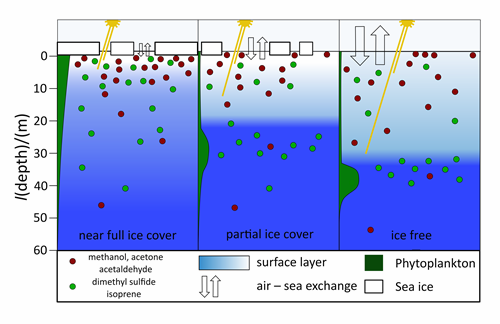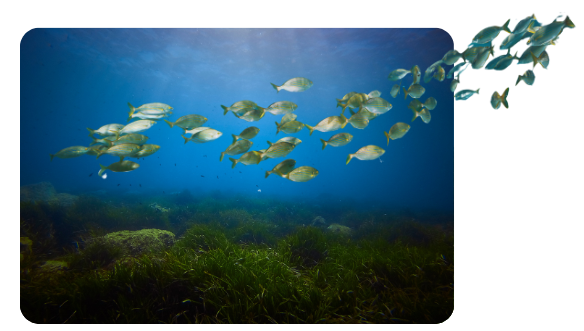Story
Sea ice concentration found to impact the exchange of gases related to climate
22 February 2022
A new study has found that sea ice extent has a profound impact upon the concentration of reactive organic gases and their exchange between Arctic waters and the atmosphere; an important aspect of polar science with impacts on atmospheric chemistry, air pollution and climate.

Picture taken on board the CCGS Amundsen where the researchers lived and worked for 5 weeks in the sea ice (Dr Charel Wohl).
The research, led by Plymouth Marine Laboratory in collaboration with the University of East Anglia, British Antarctic Survey, Rothamsted Research, University of Calgary, University of Colorado and the National Oceanic and Atmospheric Administration, led to novel measurements which showed that the amount of sea ice present has an impact on water-column concentrations of reactive organic gases and the rate at which they are absorbed or released into the atmosphere in the Arctic.
Reactive organic gases are compounds that play a major role in the chemistry of the atmosphere and, therefore, are heavily involved in inter-relations between atmospheric chemistry and climate. Previously we had little knowledge of whether the Arctic ocean, a region of rapid climate change, is a source of sink of these organic gases. To gain a better understanding, measurements of the reactive organic gases methanol, acetone, acetaldehyde, dimethyl sulfide and isoprene were taken, for the first time, in the marginal sea ice zone of the Canadian Arctic from the surface down to 60m. To achieve this, the researchers spent 5 weeks living and sampling on the ice breaker CCGS Amundsen. They had to take their instruments to sea to measure on-site due to the short lifetime of these reactive organic gases.
The marginal sea ice zone, the transitional area between open sea and dense drift ice, has been identified as a very active region for the cycling of reactive organic gases. As sea ice melts due to seasonal progression from winter to summer, the formation of a shallow surface layer leads to increased light penetration which affects concentrations of methanol, acetone and acetaldehyde. As the surface layer persists into the summer, consumption of nutrients in the surface by phytoplankton changes the concentrations of dimethyl sulfide and isoprene. This illustrates that the melting ice leads to a cascade of processes which are all likely to play a role in making marginal ice zones more productive as sources of these gases than fully ice-covered regions, especially for gas exchange.
The study team estimated that the marginal sea ice zone is absorbing methanol and acetone from the atmosphere but in contrast, dimethyl sulfide and isoprene are consistently emitted from the ocean, with marked episodes of high emissions during ice-free conditions. These emissions will likely affect the reactivity and clouds in the Arctic atmosphere, potentially causing changes to the Arctic’s climate and how ecosystems function.

Image: Schematic summarising the impact of seasonal sea ice melt on dissolved gas concentrations. The schematic illustrates that seasonal sea ice melt leads to a cascade of events which make it an area of active air-sea exchange
As the Arctic is already undergoing rapid environmental change, the impact of changes in sea ice concentration on the distributions of these important gases needs to be better understood. This is the first step for improving the accuracy of this aspect in climate and ecosystem models with a biogeochemical component.
Author of the study, Dr Charel Wohl, now Researcher at the Institut de Ciències del Mar (Barcelona) and former PhD student at Plymouth Marine Laboratory, said: “I hope that this work will be used by modellers to better constrain climate cooling feedback loops in the Arctic. Higher emission of these gases in the marginal ice zone could lead to more cloud cover and thus a cooling albedo. Including this process in computational models will probably lead to more accurate predictions of local climate change in the Arctic. My future work will focus on quantifying an even broader range of gases emitted by the oceans.”
Co-author Dr Ming-Xi Yang, Chemical Oceanographer at Plymouth Marine Laboratory, commented: “This work highlights the high variability in space and with depth near the sea surface in the marginal sea ice zone. Future use of small, autonomous marine vehicles will enable such variability to be assessed in a much higher resolution. The planned instrument upgrade (from an aged PTR-quad-MS to a state-of-the-art PTR-tof-MS) afforded by the recent Wolfson funding will also allow us to sample a much broader range of organic gases with higher sensitivity and explore the many unknowns in polar organic gas cycling.”
Co-author Dr Anna Jones, Senior Tropospheric Chemist at the British Antarctic Survey, continued: “The Arctic is the fastest warming part of our planet – as it warms, the ice melts and the natural system is disrupted. This study emphasises the tight connections between Arctic ice, ocean, and atmosphere, and how change in one will feed into change in another. Although it may feel as if it’s a long way away, the Arctic is intricately linked to the rest of the global system. It’s incredibly important to understand the present-day Arctic so that we are able to anticipate how the environment might respond to climate change over the next few decades.”
Related information
To read the paper in full, please click here.
| Gas | Role as reactive organic gas |
|---|---|
| Methanol | Affect atmospheric reactivity |
| Acetone | Affect atmospheric reactivity |
| Acetaldehyde | Affect atmospheric reactivity |
| Dimethyl sulfide | Seeds clouds; aerosol precursor |
| Isoprene | Seeds clouds; aerosol precursor |
